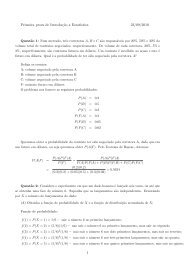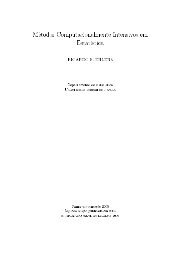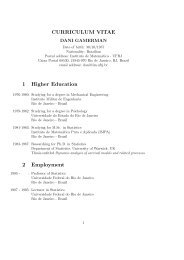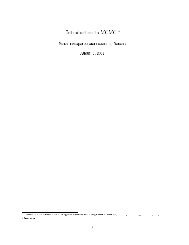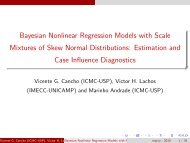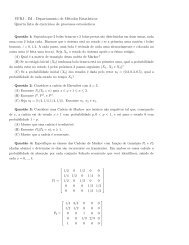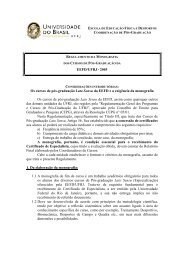Copulas: a Review and Recent Developments (2007)
Copulas: a Review and Recent Developments (2007)
Copulas: a Review and Recent Developments (2007)
You also want an ePaper? Increase the reach of your titles
YUMPU automatically turns print PDFs into web optimized ePapers that Google loves.
can be employed in probability theory to characterize dependence concepts <strong>and</strong> togenerate counter-examples as demonstrated by Nelsen (1995).Given a joint distribution function H with continuous marginals F X1 ;::: ;F Xn ,asin Sklar's Theorem, it is easy to construct the corresponding copula:C(u 1 ;::: ;u n )=H(F ¡1X 1(u 1 );::: ;F ¡1X n(u n )); (3)where F ¡1X iis the cadlag inverse of F Xi , i.e., F ¡1X i(u i )=supfx i jF Xi (x i ) · u i g,fori =1;::: ;n.Note as well that if X 1 ;::: ;X n are all continuous r<strong>and</strong>om variables with distributionfunctions as above, then C is the joint distribution function for the r<strong>and</strong>omvariables U i = F Xi (X i ), i =1;::: ;n, (i.e. obtained by the probability integral transform)which are uniformly distributed on [0; 1], to be denoted further by U(0; 1).As multivariate distributions with uniform one-dimensional margins, copulas providevery convenient models for studying dependence structure with tools that arescale-free. Alternatively, one could transform the distribution of X i to any otherdistribution, but U(0; 1) is particularly easy, being parameter free. Really, if thecontinuous r<strong>and</strong>om variables X <strong>and</strong> Y have distribution functions F <strong>and</strong> G with correspondingdensities f X <strong>and</strong> g Y ,thenY = G ¡1 (F (X)) transforms the density f X intog Y , e.g. Rohatgi (1984), p. 460.Each copula (n-copula) represents the whole class of continuous bivariate (multivariate)distributions from which it has been obtained when one-dimensional marginalswere transformed by their distribution functions. The similar property, however, doesnot hold when the original distributions are discrete, or mixed discrete-continuous. Afterthe transformation by marginal distribution functions, the copula is not uniquelyde¯ned <strong>and</strong> consequently cannot be used for dependence studies analogously as in thecontinuous case. In Section 2.1.2 we discuss thiscopulapitfall<strong>and</strong>showasolution.Strictly increasing transformations of the underlying r<strong>and</strong>om variables result inthe transformed variables having the same copula. From expression (3), we may observethat the dependence structure embodied by the copula can be recovered fromthe knowledge of the joint distribution H <strong>and</strong> its margins. Therefore, the copulaof multivariate distribution can be considered as the part describing the dependencestructure as a complement to the conduct of each of its marginals. The use of copulasis a way to solve the di±cult problem, namely ¯nding the whole multivariate distribution,by performing two simpler steps. The ¯rst one starts by modelling each marginaldistribution, <strong>and</strong> the second one consists of estimatingacopulawhichsummarizesallthe dependence structure. A c<strong>and</strong>idate can be selected from some parametric copulafamily, see Joe (1997), Section 5. But, it appears another real problem - how tochoose the right copula?For every n-copula C the usual Frechet bounds are given byà nX!max u i ¡ n +1; 0 · C(u 1 ;::: ;u n ) · min(u 1 ;::: ;u n ):i=13




